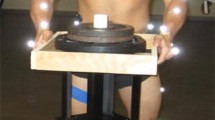Abstract
The reach level had a significant effect on isometric push-up strength for both male and female paraplegics. Whereas the reach level had a significant effect on the pull-down strength only for the male paraplegics. Significant increases of men's push-up strength were found between normal and other reach levels, maximum, and extreme. Similar results were found for the female and additionally a significant increase was found between the maximum and extreme reach levels. For male pull-down strength, a significant increase was found only between normal and extreme reach levels. The vertical angle had a significant effect only on pull-down strength for both the male and female paraplegics. Significant increases in pull-down strength were found between vertical angle Φ = 45° and other angles, 0° and −20° for male and between vertical angle Φ = 0° and other angles, 45° and −20° for female. The horizontal angle, θ, had no impact on the push-up and pull-down strengths in the present instance. For the design of a workstation for paraplegics that involves push-up and pull-down forces, consideration must be given to spacial factors.
Similar content being viewed by others
REFERENCES
Hunsicker P. Arm strength at selected degrees of elbow flexion. WADC Technical Report 54–548. United states Air Force, Project 7214.
Chaffin DB, Park KS. A longitudinal study of low-back pain as associated with occupational weight lifting factors. Am Indust Hyg Assoc J 1973; 34: 513–525.
Davis PR, Stubbs DA. Safe levels of manual forces for young males (2). Applied Ergonomics 1977; 8: 141–150.
Kumar S. Arm lift strength in work space. Appl Ergonom 1991; 22: 317–328.
Buchanan LE, Nawoczenski SA. Spinal Cord Injury: Concepts and management approaches. Baltimore Maryland: Williams and Wilkens, 1987.
Duval-Beaupere G, Robain G. Upward displacement of the centre of gravity in paraplegic patients. Paraplegia 1991; 29: 309–317.
Das B, Forde M. Isometric push-up and pull-down strengths of paraplegics in the workspace: 1. Strength measurement profiles, J Occ Rehabil 1999; 9: 277–289.
Author information
Authors and Affiliations
Rights and permissions
About this article
Cite this article
Das, B., Forde, M. Isometric Push-up and Pull-down Strengths of Paraplegics in the Workspace: 2. Statistical Analysis of Spatial Factors. J Occup Rehabil 9, 291–297 (1999). https://doi.org/10.1023/A:1021335919522
Issue Date:
DOI: https://doi.org/10.1023/A:1021335919522




